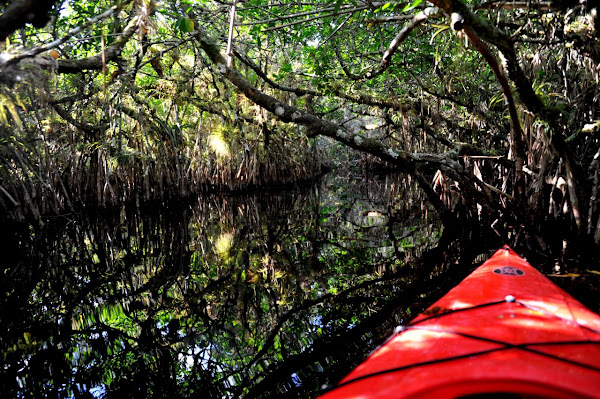Our trip to Florida was fantastic.
 |
| Last night in Florida |
|
We hadn't expected Florida to be so beautiful and interesting. Based on what we had heard from others, we imagined Florida to be boringly flat, and filled with college drunks and elderly retired people.
We saw a very different Florida. Yes, it was flat. And yes, Miami Beach was full of college drunks, and in some other parts, there was a significant number of older people. But there is so much more to it.
Florida might not have as beautiful and diverse scenery as California (though we were charmed by its picturesque beaches), but it does have amazing wildlife–like no other place I've ever seen outside Africa.
There were large colorful birds and alligators literally at every corner. Within five minutes of our arrival in Everglades National Park, we encountered the first alligator: it was lying in the middle of our hiking path, just 150-200 meters into our hike ... (more about this tomorrow).
 |
| The alligator on our path! |
|
All in all we must have seen at least 200 alligators (there are almost 2,000,000 of them in Florida ...), and even a larger number of beautiful birds (we saw many great blue herons, wood storks, black and turkey vultures, cormorants, flamingos, pelicans, tricolor and blue herons, anhingas, and others), as well as a couple of rare and endangered species (key deers and manatees).
And then there is also a coral reef, the third largest in the world. We went snorkeling in it four times (plus two times off the beach), and it was just getting better and better with every time! We saw thousands of colorful Nemo-like fish (e.g., angelfish, tangs, bluestripe snappers, trumpetfish, wrasses, surgeonfish, rockfish, sharks, barracudas, and many others that I don't know the names of). It was Anil's first snorkeling experience ever, and I was happy to see how much he was enjoying himself and growing more and more confident about it.
The fact that we were able to snorkel for up to two hours without a wet suit speaks volumes about the excellent weather that Florida enjoys year-round. I should add that the day we were flying back home to California was the coldest Florida had experienced in 35 years, and it was still not nearly as cold as some days can be in San Francisco. Apparently, it never gets too hot in Florida either, which likely explains why many older people opt to move there for retirement.
The other thing that we liked about Florida were its picturesque beaches, and stunning sunrises and sunsets. Watching the sun fall asleep in the arms of the ocean is one of the most calming, transcendental even, experiences I can imagine.
 |
| Sunset on Loggerhead Beach, Bahia Honda, Florida |
|
 |
| Sunset on Spurside Beach, Bahia Honda, Florida |
 |
| The Old Bridge, Bahia Honda, Florida |
This brings me to the highlight of our trip, which was a visit to Dry Tortugas National Park, located on a lonely island some 70 miles away from the nearest land. The island is the most picturesque and serene place I've been to in a while. It has absolutely perfect beaches with white sand, palm trees, and gorgeous turquoise waters; great snorkeling; and it's not crowded at all. This park alone is a good reason to visit (or re-visit, in our case) Florida.
 |
| Fort Jefferson, Dry Tortugas National Park |
The last day and a half of our trip we spent in the Miami/Miami Beach area, which reminds me about a few things that we
didn't like about Florida.
First, people appear to be more rude there: they don't smile, apologize, say "thank you", or ask "how are you?"; they cut into lines at grocery shops and restrooms; most drive like maniacs and start honking if you dare to wait for pedestrians to cross the street, or if you drive "too slow", which would be less than 20-30 miles above the speed limit ... Suffice to say that even my super-patient and easy-going husband started to grow frustrated and annoyed with driving in Miami after just two days.
Second, we were amazed how difficult it is to navigate streets of Miami and neighboring cities. We had forgotten our GPS at home, so we had to rely on maps, which cost us some nerves, but at the same time it also helped us to become more familiar with the city's messy layout. Like most bigger American cities, Miami has a grid system for street naming. In most cities such a grid makes finding locations easy. Not in Miami. Whoever designed its grid system must have been on coke, as it completely does not make sense. For example, would you find it obvious that to get from SW 2nd to SW 4th Avenues, you need to drive on SW 13th Street and SW 18th Terrace? Similarly, we were amused to see that one of the streets, SW 8th St, is known by at least nine names, used interchangeably: Calle Ocho, Tamiami Trail, Route 41, Route 90, Fellipe Walls Way, Olga Guillot Way, Carlos Arboleya Blvd, Celia Cruz Way, and SW 8th St.
 |
| Calle Ocho aka Tamiami Trail, Route 41, Route 90, Fellipe Walls Way, Olga Guillot Way, Carlos Arboleya Blvd, Celia Cruz Way, and SW 8th St |
By the time you are done reading all of those names, you might have taken a wrong turn ...
So unless you like partying, I'd recommend avoiding the Miami area. Florida's beautiful nature and diverse wildlife is what distinguishes it from other states, and I'd recommend focusing on enjoying those. In the next few posts, I'll share with you some tips on the best places to visit for nature and wildlife viewing in Florida. Hope you'll enjoy it!


















































